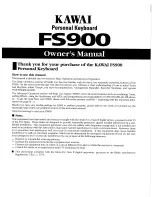
Disk Mode
Saving Files
13-28
The
Search Algorithm
used for relinking dependent objects to their parent objects during
loading is as follows:
The search for a dependent object (whose name matches that of an entry in the name table)
begins at the beginning of the bank that is speciÞed for loading the parent Þle.
All possible
IDs are then consecutively searched. When the last ID of the 900's bank has been searched
(typically 999), the search will wrap around to ID 1 up until the end of previous bank to the
speciÞed bank. The search stops once a dependent with a matching name has been found and
relinked.
For example, if a Þle containing a one-layer program is loaded into the "400's" bank, and the
Þle includes a Name Table that lists the layer's keymap by name, then the K2vx will begin to
look through all possible keymap IDs starting at 400, until ID 999. The search then continues
from ID 1, stopping at ID 399. If the search does not successfully Þnd a match, the dependent
will be unresolved, and in this example the program would have an "
object id
Not found"
indication in its Keymap parameter, where the
object id
is the value that was stored in the Þle.
The search is done in this "circular" manner so as to allow you to direct which dependent
objects get re-linked. This may be necessary if you end up with multiple copies of dependent
objects with the same name; you can differentiate between them by loading the parent Þle into
a speciÞc bank that is the same bank or "before" the bank containing the objects you wish to re-
link to. Note that this can only be taken so far, since it would be impossible for the K2vx to
differentiate between objects with the same name within the
same
bank.
The re-linking process happens in the background, without any notiÞcation or error messages if
items cannot be relinked.
Working with Relink-by-Name
Here are a couple of more in-depth examples that can show how Relink-by-Name works in a
practical situation.
Consider that your K2vx's RAM contains the following one-layer program and also its
dependent keymap and samples (the techniques used in this example could well apply no
matter how many programs with any number of layers you want to save):
Program:
Program 317 Steinwave Piano
Keymap:
Keymap 300 Steinwave Piano
Samples:
Sample 300 StwaveG1 .......... Sample 310 StwaveC7
In this case you might wish to save the samples and the keymap in one Þle, and the Program in
another Þle. So, from the Save Object dialog you could Þrst select all the Samples 300-310, and
Keymap 300, for saving into a Þle, let's say
STWAVE1.KRZ
.
You would then return to the Save Object dialog and save just Program 317 in a separate Þle in
the same directory, let's say
STWAVE2.KRZ
....only this time, you will be asked the "Save
dependent objects" question pictured above. Answer this by pressing
Names
.
After saving, the Þle STWAVE2.KRZ will contain two objects in it, Program 317 and a Name
Table. You can easily verify this by going to the Load function (or any other disk function) and
Содержание K2500RS
Страница 12: ...Table of Contents TOC 12...
Страница 16: ...Introduction How to use this manual 1 4...
Страница 32: ...User Interface Basics The Panel Play Feature K2vxR 3 8...
Страница 106: ...Effects Mode and the Effects Editor Configurations and Parameters 9 24...
Страница 186: ...Song Mode Recording Multi timbral Sequences via MIDI 12 52...
Страница 304: ...DSP Functions Hard Sync Functions 14 52...
Страница 394: ...Programs Setups and Keymaps K2500 ROM Keymaps 21 12...
Страница 402: ...LFOs LFO Shapes 23 4...
Страница 406: ...Note Numbers and Intonation Tables List and Description of Intonation Tables 24 4...
Страница 434: ...DSP Algorithms 26 14...
Страница 450: ...MIDI and SCSI Sample Dumps SMDI Sample Transfers 29 8...
Страница 464: ...Glossary 31 6...
Страница 490: ...K2vx Program Farm VOX K25 Appendix A 22...
Страница 494: ...K2vx Compatibility Converting programs from the K2vx to K2000 Appendix B 4...
















































